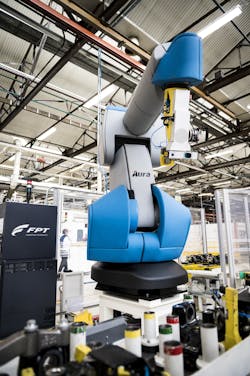Collaborative robots (cobots) have been a fixture of the manufacturing landscape for some time now, with the very first cobot sold to Danish plastic and rubber supplier Linatex back in 2008. At the time, cobots were largely relegated to simple, repetitive tasks capable of being performed by small, low-payload robots, such as machine tending for computer numeric control (CNC) applications. However, as technology has evolved, cobots have increasingly been integrated with more sophisticated sensors, vision systems, and control software, allowing their reach, speed, and payload capacities to improve.
As this trend continues, accelerating adoption is expected. PMMI’s 2019 business intelligence report “Robotics: Innovation 2 Implementation,” predicts that while cobots only accounted for 3% of all robot sales in North America in 2017, that number will swell to 34% by 2025.
Not only does this growth in the cobot space represent an exciting shift for those interested in the technology, it sounds a positive note for those who may fear that automation could displace human workers. Because humans work alongside cobots rather than seeing their roles eliminated entirely, cobots are often seen as a friendly face for the rapid expansion of robotics in industry.
FPT Powertrain Technologies’ industrial driveline plant in Turin, Italy, recently expanded its collaborative manufacturing capabilities with the adoption of Comau’s Advanced Use Robotic Arm (AURA). This robotic arm was designed in coordination with the human-centered manufacturing system (HuManS) project, launched in the Piedmont region of Italy by FPT, Comau, and 17 other companies.
Standing nearly three meters high and weighing in at three tons, AURA has a payload capacity of 170 kg (~375 lbs)—one of the highest of any cobot on the market. In addition to eliminating the need for fencing and barrier requirements, AURA is capable of being manually guided by human workers.
AURA’s hand-guiding capabilities are enabled by a touch-sensitive skin that covers its surface, which allows it to slow its speed and force when it comes into contact with a human operator. Moreover, 3D vision-enabled cameras are used to scan equipment and supply crates being retrieved by AURA to maximize its accuracy. Finally, a laser scanning system continuously monitors AURA’s workspace for speed and separation monitoring purposes.
“The synergy between two leading companies in the technological field, such as FPT Industrial and Comau, has led to an innovative solution focused on the collaborative AURA robot,” said Pietro Ottavis, chief technology officer for Comau. “Cobots and digital instruments are just some of the main technologies that Comau has developed following its own approach to Industry 4.0, called HuManufacturing, to create safe collaboration in production operations between humans and machines, called on to support humans in operations that require greater speed, strength, and repeatability, as well as dangerous operations.”
About the Author
David Miller
Former Senior Technical Writer

Leaders relevant to this article:

